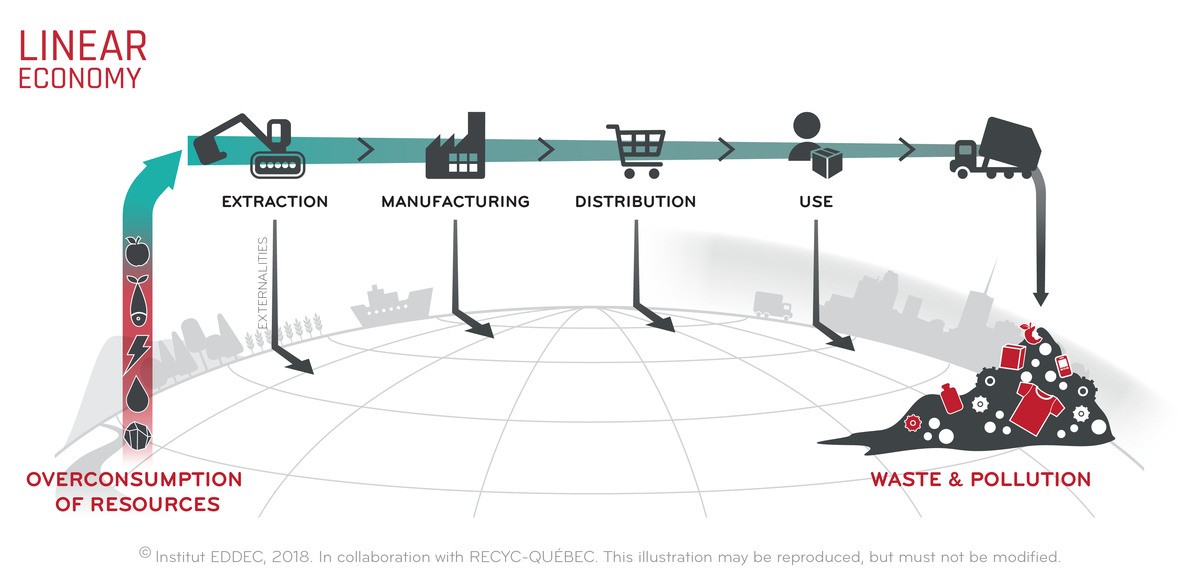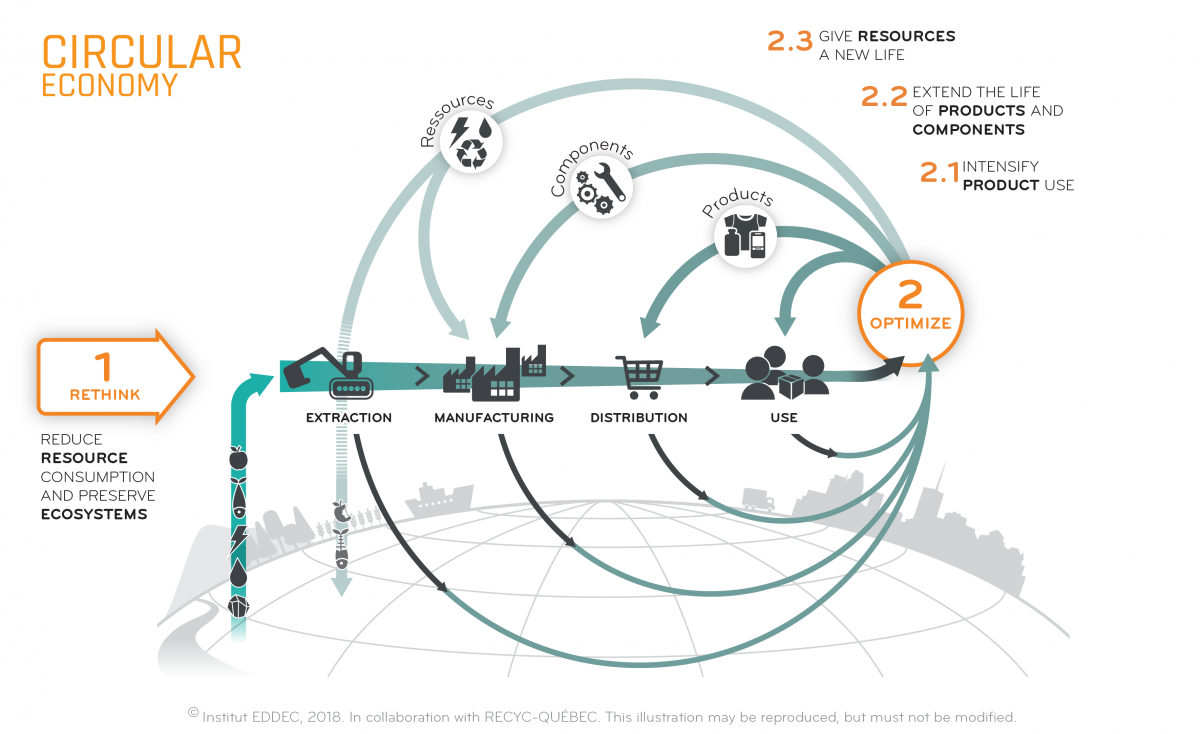Issues and definition
Did you know that?
- Every year, humanity consumes the equivalent of 1.75 planets’ worth of renewable resources, and the point when this is exceeded (Overshoot Day) occurs earlier and earlier each year.
- Several essential resources are already at a critical level in terms of availability.
- If the trend remains, global use of material resources will double between 2015 and 2050 (in French).
- The world is only 7.2% circular.
This crisis is not surprising given the exponential population growth, but it is also due to our current mainly linear economic model based on high resource consumption, while generating considerable material losses and waste at all stages of the production-consumption chain.
The capsule Rethinking progress, produced by the Ellen MacArthur foundation, sums up the concept well.
Download the diagram in french
Download the diagram in english

Opportunities to be taken
The transition to a new economic model is inevitable. Current challenges can turn into opportunities!
- In Québec, 41% of food is rejected along the food chain, from land (or sea) to table, for a total of 3.1 million tons.
- Also in Québec, nearly 60% of the energy consumed by the industrial sector is lost and does not generate added value, despite recent initiatives on the valorization of thermal waste.
- Fewer than 10% of extracted resources are put back into circulation once they have been used. The Québec economy is 3.5% circular, a 96% circularity gap.
- The European Green Deal offers an action plan aiming to promote the efficient use of resources by transitioning to a clean and circular economy
The good news is that several people, perhaps including you, have already begun to develop a new economic model that transforms these losses and waste into useful resources for our society: the circular economy
Taking part in the transition
Would you too like to take part in Quebec's transition to the circular economy? Several options are available to you!
- Become a member of Québec Circulaire and stay informed of the latest news by subscribing to the newsletter.
- Draw inspiration from concrete examples involving your organization, region or sector and share a circular economy initiative.
- Take part in events and courses.
- Check out the tools available to start up a citizen, local initiative, within your organization or sector.
- Consult the publications and the latest reports on the circular economy to familiarize yourself with the concept.
Downlad the diagram in french
Download the diagram in english

This is the simplified diagram of the circular economy developed by the EDDEC Institute and Quebec stakeholders. To download the complete diagram illustrating the strategies of the circular economy, see the section on circularity strategies.
The circular economy is a new economic model that aims to dissociate economic growth from the depletion of natural resources and environmental impact through two main mechanisms:
1) Rethinking our production-consumption patterns to consume fewer resources and protect the ecosystems that generate them.
2) Optimizing the use of resources that are already circulating in our societies.
Definition
In the absence of an international consensus definition, the EDDEC Institute as well as fifteen strategic players for the deployment of the circular economy in Quebec (Pôle québécois de l’économie circulaire) have co-constructed a Quebec definition of the circular economy:
« A production, exchange and consumption system aiming to optimize resource use in every stage in the life cycle of a product or service through a circular approach, reduce the environmental footprint and contribute to the well-being of individuals and communities »
Pôle québécois de concertation sur l’économie circulaire
Vocabulary of circular economy
The Office québécois de la langue française has launched a vocabulary for the circular economy, which presents the French terminology for over 120 concepts associated with the field! It also indicates the equivalents in English.
The first references to the circular economy date back to the report The limits to growth, produced in 1972 by researchers at the Massachusetts Institute of Technology (MIT), and to the publication Product-life factor, by Walter Stahel (1982). However, this concept was put on hold for about thirty years before being revisited and put forward again in 2009 by the Ellen MacArthur Foundation.
Economic, social and environmental benefits
A study of the economic benefits of the circular economy highlights the expected benefits of the circular economy at national level:
- Reduced pressure on resources
- Increase in gross domestic product (GDP)
- Local job creation
- Greenhouse gas emissions significantly reduced
It also identifies other studies that quantify the benefits for specific sectors and organizations, but also for specific circular economy strategies. For example, reconditioning would allow the United Kingdom to:
- Reduce production costs by 34%
- Reduce procurement costs by 70%
- Lower the selling price by 20%
- Double job creation
FAQ
Yes! Several circularity strategies emerged long before the term circular economy was used. This is the case for industrial ecology, recycling and eco-design, for example.
Applied in isolation, these strategies cannot change the linear economic model that severely hinders their deployment.
The incorporation of value chains and the cooperation of all those involved are essential to meet this challenge and multiply the impact of circularity strategies. For example, responsible procurement can be based on the use of eco-designed products, which are themselves made from recycled materials.
By deploying them in a concerted manner and enhancing the value of the collective impact of such a wide variety of players, the circular economy can create the necessary leverage to reform our production and consumption patterns.
The transition to a circular economy is still in its infancy, both in Quebec and internationally. The Ellen MacArthur Foundation estimates that it will take between 15 and 20 years before this model becomes predominant.
No! The circular economy is the new model that is being deployed on all continents: already, several Asian and European countries have adopted laws, objectives and programmes. In Canada, a Coalition on the circular economy has been created, particularly at the instigation of multinationals and NGOs. Initiatives are multiplying all over the world, emanating from a multitude of players.
The increasing scarcity of natural resources is unprecedented for humanity. It is combined with climate change, which will have its share of impacts on the ecosystems that help to generate these precious resources. This situation cannot be overcome without a fundamental change in our linear economic model.
It is true that the circular economy is a new concept to be understood. However, in terms of mobilizing the people involved, this model offers several advantages:
- It provides an essential response to the commitment of managers: an economic approach focused on the current challenges facing regions and organizations, with estimated potential benefits.
- It is a framework of solutions rather than a set of problems to be solved: in addition to being much more attractive than a list of environmental and social problems to be managed, this approach facilitates action and individual commitment.
- It provides the opportunity to clearly show the societal movement to which everyone contributes: by consulting the map of initiatives , the people involved can finally be convinced that their contribution has a real influence and that they are not alone in their commitment, thus silencing very frequent objections in sustainable development, such as: “as long as China doesn’t get involved, as SMEs don’t get involved, as my boss doesn’t believe in it,...”